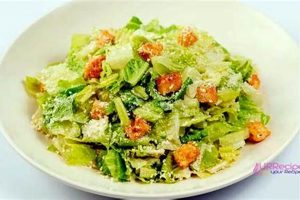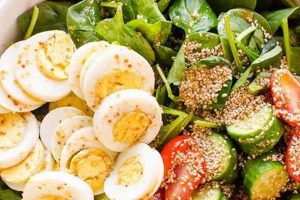A dish featuring prepared, cooked, or imitation seafood combined with rice and other ingredients like vegetables, seaweed, and sesame seeds, all conforming to Jewish dietary laws, constitutes this culinary concept. An example might include cooked salmon flakes mixed with seasoned sushi rice, cucumber, avocado, and a dressing made with kosher ingredients.
Observant Jewish individuals seeking to enjoy the flavors and textures reminiscent of sushi while adhering to kashrut find this type of preparation valuable. It offers a flexible and creative way to incorporate elements of Japanese cuisine within a kosher diet. Historically, adapting global cuisines to fit Jewish dietary laws has been a significant aspect of Jewish culinary tradition, reflecting both cultural exchange and religious observance.
The following sections will explore specific kosher ingredients suitable for this dish, variations on preparation techniques, and suggested dressings that complement the core components while maintaining kashrut.
Tips for Preparing a Kosher Sushi Salad
Careful ingredient selection and preparation techniques are essential for creating a successful kosher sushi salad. The following tips offer guidance for achieving optimal flavor and texture while adhering to dietary laws.
Tip 1: Ensure Fish Authenticity and Preparation: Utilize only fish species known to be kosher. Fish must have both fins and scales to be considered kosher. Furthermore, the fish should be cooked thoroughly or, if using imitation crab or other seafood substitutes, ensure they possess reliable kosher certification.
Tip 2: Rice Selection and Seasoning: Short-grain or medium-grain rice works best for sushi salads. Season the cooked rice with a mixture of kosher rice vinegar, sugar, and salt, ensuring all ingredients are certified kosher.
Tip 3: Vegetable Incorporation: Incorporate fresh vegetables like cucumber, avocado, carrots, and edamame to enhance flavor and texture. Ensure all produce is thoroughly washed and inspected before use.
Tip 4: Seaweed Selection: Nori, the dried seaweed sheets commonly used in sushi, is generally considered kosher. However, it is recommended to choose certified kosher nori to eliminate any concerns regarding processing or additives.
Tip 5: Dressing Considerations: Prepare dressings using kosher ingredients. Combinations of kosher mayonnaise, soy sauce (ensure it’s certified kosher), sesame oil, and rice vinegar offer flavorful options.
Tip 6: Mindful Utensil Usage: If strict kashrut observance is required, use separate utensils and preparation surfaces for meat and dairy to prevent cross-contamination, especially if incorporating ingredients like mayonnaise into the dressing.
Tip 7: Presentation and Serving: The visual appeal enhances the dining experience. Consider arranging the salad attractively on a platter or in individual bowls, garnished with sesame seeds or finely chopped scallions.
By following these guidelines, one can create a delicious and satisfying kosher sushi salad that honors both culinary and religious traditions.
These tips offer a practical foundation for preparing this dish. The following section will present concluding thoughts and encourage further exploration of kosher culinary practices.
1. Kosher Ingredients
Kosher ingredients are fundamental to a kosher sushi salad recipe. Kashrut, the Jewish dietary law, dictates permissible food items and their preparation methods. The core components of a sushi saladfish, rice, vegetables, seaweed, and dressingsmust all adhere to these regulations. For instance, fish must have both fins and scales; shellfish are prohibited. Using imitation crab meat requires kosher certification. Rice vinegar, a common ingredient in sushi rice seasoning, should also be certified kosher. Even seemingly innocuous ingredients like soy sauce can present kashrut concerns due to potential non-kosher fermentation processes; thus, using a kosher-certified soy sauce is crucial.
This reliance on kosher ingredients extends beyond individual components to the overall preparation process. Cross-contamination between meat and dairy, a central tenet of kashrut, becomes relevant when incorporating ingredients like mayonnaise-based dressings. Strict adherents often maintain separate utensils and preparation areas for meat and dairy to prevent such mixtures. Understanding these intricacies is essential for crafting a truly kosher sushi salad. A seemingly minor oversight, such as using non-kosher rice vinegar or soy sauce, can compromise the entire dish’s kosher status.
In summary, the connection between kosher ingredients and a kosher sushi salad recipe is absolute. Adherence to kashrut hinges on the exclusive use of kosher-certified ingredients and meticulous attention to preparation techniques. This understanding empowers individuals observing Jewish dietary laws to enjoy culinary creations like sushi salad while upholding their religious practices. The practical significance lies in fostering inclusivity and allowing for the adaptation of diverse cuisines within a kosher framework.
2. Cooked or Imitation Fish
The use of cooked or imitation fish is integral to a kosher sushi salad recipe due to the restrictions imposed by Jewish dietary laws (kashrut) on seafood consumption. Kashrut permits only fish with both fins and scales. Common sushi ingredients like tuna, salmon, and yellowtail meet these criteria; however, they are traditionally served raw in many sushi preparations. To adhere to kashrut, these fish must be cooked thoroughly before inclusion in a kosher sushi salad. This requirement significantly impacts ingredient selection and preparation methods. For instance, a kosher sushi salad might feature cooked, flaked salmon instead of raw salmon slices found in conventional sushi.
Imitation fish products, often made from surimi (processed white fish), offer an alternative for those seeking the flavor and texture of shellfish like crab or lobster, which are not kosher. However, even imitation seafood requires careful consideration. Not all imitation crab or lobster is inherently kosher due to potential additives or processing methods. Therefore, opting for certified kosher imitation seafood products is essential for maintaining the dish’s kosher status. This distinction highlights the importance of scrutinizing ingredient labels and seeking reliable kosher certifications when creating a kosher sushi salad. A salad featuring imitation crab, for example, must utilize a kosher-certified imitation crab product to align with dietary laws.
In summary, the choice of cooked or imitation fish directly impacts a sushi salad’s adherence to kashrut. Using cooked, permitted fish species or certified kosher imitation seafood ensures compliance with dietary laws. This understanding underscores the adaptability of culinary traditions to accommodate religious practices, demonstrating how even dishes with inherently non-kosher elements can be modified to fit within a kosher framework. The practical implications are substantial, allowing observant individuals to enjoy a wider range of culinary experiences while upholding their religious beliefs.
3. Sushi Rice
Sushi rice, distinct from regular short- or medium-grain white rice, plays a pivotal role in a kosher sushi salad recipe. Its unique characteristica sticky texture achieved through specific preparation methodsis essential for binding the salad ingredients and providing the desired culinary experience. The preparation process involves rinsing the rice thoroughly to remove excess starch, then cooking it with a precise water ratio. Subsequently, the cooked rice is seasoned with a mixture of rice vinegar, sugar, and salt. This seasoning, while seemingly simple, imparts the characteristic tangy and slightly sweet flavor profile that defines sushi rice. Critically, all ingredients used in both the cooking and seasoning processes, including the rice, vinegar, sugar, and salt, must be certified kosher to maintain the overall dish’s kosher status. For instance, using a seasoned rice vinegar blend that contains non-kosher additives would render the entire salad non-kosher.
The importance of correctly prepared sushi rice extends beyond mere flavor. It provides the foundation upon which the other ingredients are built. The sticky consistency allows the salad to hold its shape and prevents it from becoming watery or falling apart. This structural integrity is crucial for a visually appealing and enjoyable eating experience. Consider a kosher sushi salad made with plain cooked rice; it would likely lack the desired cohesive texture and authentic sushi flavor profile, diminishing its overall quality. Furthermore, the specific preparation of sushi rice allows for a more even distribution of flavors from the seasonings and other ingredients, enhancing the overall taste and ensuring a balanced culinary experience. The practical implication is clear: correctly prepared sushi rice significantly elevates the quality of a kosher sushi salad.
In conclusion, sushi rice is not merely a filler ingredient but a defining component of a kosher sushi salad recipe. Its unique properties, achieved through specific preparation techniques using kosher-certified ingredients, contribute significantly to the salad’s texture, flavor, and overall culinary appeal. Understanding this connection underscores the attention to detail required in kosher cooking and highlights how seemingly minor variations in preparation can significantly impact a dish’s adherence to dietary laws and its overall quality. The selection and preparation of sushi rice directly influence both the taste and the kosher status of the final product, reinforcing the importance of informed ingredient selection and preparation methods within a kosher culinary framework.
4. Flavorful additions
Flavorful additions are essential for elevating a kosher sushi salad recipe beyond its basic components. While adhering to kashrut is paramount, these additions provide depth, complexity, and textural contrast, transforming the dish into a more compelling culinary experience. Understanding their role and selecting appropriate ingredients within the boundaries of Jewish dietary laws is crucial for creating a truly satisfying and authentic kosher sushi salad.
- Vegetables
Fresh vegetables contribute both flavor and texture. Common choices include cucumbers, avocados, carrots, and edamame. These additions offer crispness and freshness, contrasting with the soft texture of the rice and fish. Crucially, all produce must be thoroughly washed and inspected to ensure they are free from insects, which are not kosher. The choice of vegetables can also reflect seasonal availability and personal preferences, allowing for customization while maintaining kashrut.
- Seaweed
Nori, a dried seaweed sheet, is a staple in sushi preparation. Its umami flavor and slightly salty taste complement the other ingredients. While generally considered kosher, selecting nori with reliable kosher certification is recommended to avoid potential concerns regarding processing or additives. Nori can be incorporated in various forms, such as shredded, toasted, or as a wrapper for the salad ingredients.
- Sesame Seeds
Sesame seeds offer a nutty flavor and a satisfying crunch. Toasted sesame seeds further enhance their aroma and taste. They are generally considered kosher but, as with other ingredients, checking for kosher certification provides additional assurance. Sesame seeds can be sprinkled over the salad or incorporated into the dressing.
- Dressings and Sauces
Dressings and sauces contribute significantly to the overall flavor profile. A simple dressing made with kosher-certified mayonnaise, rice vinegar, and a touch of sesame oil can enhance the salad’s richness and complexity. Alternatively, a mixture of kosher soy sauce, rice vinegar, and sugar offers a more traditional sushi flavor. The key is to use only kosher-certified ingredients, particularly when using products like mayonnaise or soy sauce, which may contain non-kosher additives or be processed using non-kosher equipment.
The careful selection and incorporation of these flavorful additions elevate a kosher sushi salad from a simple combination of ingredients to a well-rounded and satisfying culinary creation. By understanding the role of each addition and adhering to kashrut guidelines, individuals can create a dish that honors both culinary and religious traditions. These flavorful additions not only enhance the taste and texture but also provide an opportunity for creativity and customization within the framework of kosher dietary practices.
5. Proper Preparation
Proper preparation is paramount in creating a kosher sushi salad recipe. It goes beyond simply combining ingredients; it involves a meticulous approach that respects both culinary and religious principles. This careful execution ensures the final dish adheres to Jewish dietary laws (kashrut) while maximizing flavor and presentation. The following facets highlight the critical role of proper preparation in achieving this balance.
- Ingredient Sourcing and Verification
Proper preparation begins with sourcing kosher-certified ingredients. This necessitates careful scrutiny of product labels and, in some cases, consulting kosher certification agencies. Using ingredients without reliable kosher certification compromises the dish’s kashrut status. For example, seemingly simple ingredients like soy sauce or rice vinegar can contain non-kosher additives or be processed using non-kosher equipment. Verifying the kosher status of each ingredient, including produce for insect infestation, is fundamental to proper preparation.
- Utensil and Surface Considerations
Maintaining separate utensils and preparation surfaces for meat and dairy products is crucial for strict kashrut observance. Cross-contamination between meat and dairy is strictly prohibited. This requires designated cutting boards, knives, bowls, and other utensils for each category. In the context of a sushi salad, this becomes relevant when incorporating dairy-based ingredients like mayonnaise in dressings. Proper preparation necessitates using separate utensils for these components to prevent any possibility of mixing meat and dairy.
- Fish Handling and Cooking Techniques
Proper preparation of fish is essential for both kashrut and food safety. Kosher fish species must be cooked thoroughly. This eliminates concerns about parasites and ensures the dish aligns with dietary laws. Furthermore, the fish must be handled with utensils designated for fish to avoid cross-contamination with meat or dairy. This dedicated approach underscores the importance of respecting specific kosher preparation guidelines.
- Rice Preparation and Seasoning
Sushi rice preparation requires meticulous attention to detail. Rinsing the rice thoroughly to remove excess starch and cooking it with a precise water ratio are critical steps. The subsequent seasoning with kosher-certified rice vinegar, sugar, and salt must also be executed carefully to achieve the desired flavor and texture. These steps, while seemingly minor, significantly impact the overall quality and kashrut status of the final dish. Using non-kosher seasonings or neglecting proper rinsing techniques can compromise both taste and adherence to dietary laws.
These facets of proper preparation demonstrate the interconnectedness of culinary technique and religious observance in creating a kosher sushi salad recipe. Each step, from ingredient sourcing to final assembly, contributes not only to the dish’s flavor and presentation but also to its adherence to kashrut. This meticulous approach reflects a deep respect for tradition and highlights how proper preparation elevates a simple dish into a meaningful culinary and religious experience.
Frequently Asked Questions
This section addresses common inquiries regarding the preparation and consumption of kosher sushi salad, providing clarity on key aspects of ingredient selection, preparation methods, and adherence to Jewish dietary laws.
Question 1: Can raw fish be used in a kosher sushi salad?
Raw fish, even kosher species, is generally avoided in kosher sushi salad due to concerns about parasites and strict interpretations of Jewish dietary laws. Cooked fish or kosher-certified imitation seafood are preferred alternatives.
Question 2: Is all imitation crab meat kosher?
Not all imitation crab meat is kosher. Many varieties contain non-kosher additives or are processed using non-kosher equipment. It is essential to select imitation crab meat with reliable kosher certification.
Question 3: What type of rice is best for kosher sushi salad?
Sushi rice, specifically short-grain or medium-grain Japanese rice, is recommended for its sticky texture, which is essential for binding the salad ingredients. Using regular long-grain rice will result in a different texture and may not hold the salad together as effectively.
Question 4: Are all seaweeds kosher?
While many seaweeds, including nori, are generally considered kosher, using certified kosher seaweed is recommended to eliminate any concerns regarding processing or potential additives. This ensures the dish adheres strictly to dietary laws.
Question 5: What are some kosher alternatives to traditional sushi dressings?
Kosher mayonnaise combined with rice vinegar and sesame oil makes a suitable dressing. Alternatively, a mixture of kosher-certified soy sauce, rice vinegar, and sugar offers a more traditional flavor profile. The crucial aspect is ensuring all ingredients used, including the soy sauce, are certified kosher.
Question 6: How can cross-contamination between meat and dairy be avoided when preparing kosher sushi salad?
Maintaining separate utensils, cutting boards, and preparation surfaces for meat and dairy ingredients is crucial. This prevents accidental mixing, which is prohibited under Jewish dietary laws. This is particularly relevant when using dairy-based dressings, such as those containing mayonnaise.
Understanding these common concerns facilitates informed decision-making in preparing a kosher sushi salad that adheres to both culinary and religious standards. Careful attention to ingredient selection, preparation techniques, and potential cross-contamination ensures a truly kosher and enjoyable culinary experience.
The subsequent section provides a sample kosher sushi salad recipe incorporating these principles.
Conclusion
This exploration of kosher sushi salad recipes has highlighted the multifaceted nature of adapting culinary traditions to specific dietary requirements. Key aspects include the mandatory use of kosher-certified ingredients, the reliance on cooked or imitation fish, the significance of properly prepared sushi rice, and the careful selection of flavorful additions like vegetables, seaweed, and dressings. Furthermore, meticulous attention to preparation techniques, including the prevention of cross-contamination between meat and dairy, is crucial for maintaining the dish’s kosher status.
The ability to enjoy a dish inspired by global cuisine while adhering to religious dietary laws underscores the adaptability and richness of culinary traditions. Further exploration of kosher culinary practices offers a pathway to both cultural appreciation and religious observance. This intersection of food and faith provides a lens through which to examine broader themes of cultural exchange, dietary diversity, and the dynamic interplay between tradition and innovation within the culinary world.






